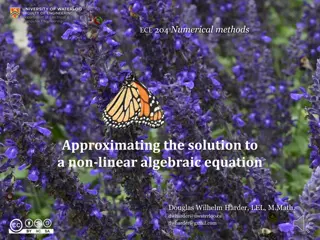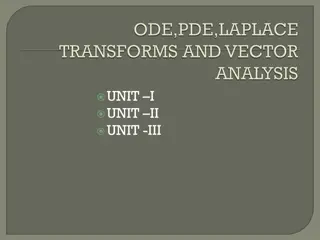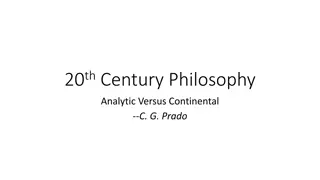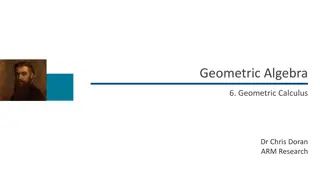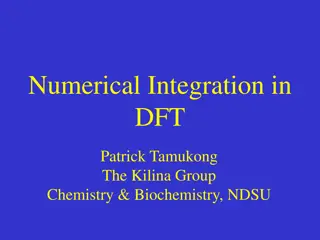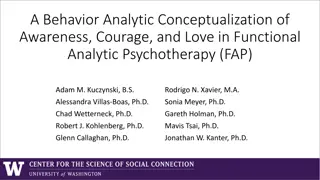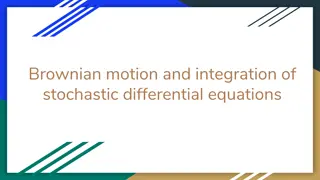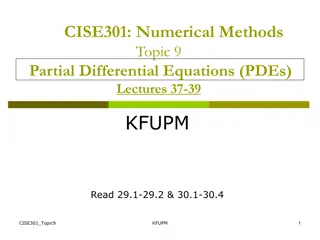Understanding Numerical Methods for Approximating Analytic Equations
Introduction to approximating solutions to analytic equations, focusing on differential equations, integral equations, and integro-differential equations. Exploring ordinary and partial derivatives, differential and integral equations, and the involvement of unknown functions and their derivatives and integrals in the equations.
- Numerical methods
- Analytic equations
- Approximation techniques
- Differential equations
- Integral equations
Download Presentation

Please find below an Image/Link to download the presentation.
The content on the website is provided AS IS for your information and personal use only. It may not be sold, licensed, or shared on other websites without obtaining consent from the author. Download presentation by click this link. If you encounter any issues during the download, it is possible that the publisher has removed the file from their server.
E N D
Presentation Transcript
ECE 204 Numerical methods Approximating the solution to analytic equations Douglas Wilhelm Harder, LEL, M.Math. dwharder@uwaterloo.ca dwharder@gmail.com
Approximating solutions to analytic equations Introduction In this topic, we will Describe what will be covered in the next section Approximating solutions to analytic equations Describe differential, integral and integro-differential equations Explain why we are focused on differential equations Look at the approach we will use 2
Approximating solutions to analytic equations Analytic equations In your calculus course, you have been introduced to two flavors of differential equations (DEs): Ordinary differential equations (ODEs) Partial differential equations (PDEs) Together with DEs, analytic equations can also contain integrals Engineers focus on DEs, but all techniques are applicable to: Differential equations Integral equations Integro-differential equations 3
Approximating solutions to analytic equations Differential equations An ordinary derivative is the derivative of a function of one variable with respect to that variable d d ( ) y t ( )( ) 1 y t t A partial derivative is a derivative of a function of two or more variables with respect to one of those variables while holding the other variables constant Partial differentiation assumes no variable depends on the other variables ( ) , , ( ) ( ) x , u t , , u t x y x u t x y x t 1 4
Approximating solutions to analytic equations Analytic equations A differential equation involves an unknown function and its derivatives v(t) L R ( )( ) ( ) ( ) v t + 1 + = Li t Ri t An integral equation involves an unknown function and its integrals: R + t 1 C ( ) ( ) 0 v t ( ) ( ) v t + + = d Ri t i v(t) C t 0 An integro-differential equation involves an unknown function and its integrals and derivatives: t 1 C ( )( ) ( ) ( ) 0 v t ( ) ( ) v t 1 + + + = R d Li t Ri t i + v(t) L C t 0 5
Approximating solutions to analytic equations Tools By taking derivatives, integral and integro-differential equations can be converted to pure differential equations: ( )( ) ( ) ( ) Li t Ri t v t + + t 1 C 1 C ( ) ( ) v t 1 + = d i 0 t ( ) i t 0 ( )( ) ( )( ) ( )( ) 2 1 1 + + = Li t Ri t v t Maxwell s equations can be written either as integral equations or partial differential equations 1 = = E S E d d V R R 0 0 To make life simple, engineers focus on differential equations 6
Approximating solutions to analytic equations Analytic equations In this section, we will look at: Approximating solutions to problems involving ordinary differential equations Approximating solutions to problems involving partial differential equations 7
Approximating solutions to analytic equations Approach In each case, we will be attempting to approximate a continuous and differentiable function We cannot approximate such a function everywhere Instead, we will, for example, approximate the function at specific points and we can interpolate values in between 8
Approximating solutions to analytic equations Approach For example, if we are finding a function of one variable y(t), we will approximate the function at points tk and find approximations yk y(tk) t 9
Approximating solutions to analytic equations Approach In finding a function of one two variables u(t, x), we will approximate the function at points (t , xk)and find approximations u ,k u(t , xk) x t 10
Approximating solutions to analytic equations Summary Following this topic, you now Have an overview of the ideas to be covered in this section Are aware that there are differential, integral and intego- differential equations Understand we will focus on ordinary and partial differential equations Are aware of the approach we will use 11
Approximating solutions to analytic equations References [1] [2] https://en.wikipedia.org/wiki/System_of_linear_equations https://en.wikipedia.org/wiki/Nonlinear_system 12
Approximating solutions to analytic equations Acknowledgments None so far. 13
Approximating solutions to analytic equations Colophon These slides were prepared using the Cambria typeface. Mathematical equations use Times New Roman, and source code is presented using Consolas. Mathematical equations are prepared in MathType by Design Science, Inc. Examples may be formulated and checked using Maple by Maplesoft, Inc. The photographs of flowers and a monarch butter appearing on the title slide and accenting the top of each other slide were taken at the Royal Botanical Gardens in October of 2017 by Douglas Wilhelm Harder. Please see https://www.rbg.ca/ for more information. 14
Approximating solutions to analytic equations Disclaimer These slides are provided for the ECE 204 Numerical methods course taught at the University of Waterloo. The material in it reflects the author s best judgment in light of the information available to them at the time of preparation. Any reliance on these course slides by any party for any other purpose are the responsibility of such parties. The authors accept no responsibility for damages, if any, suffered by any party as a result of decisions made or actions based on these course slides for any other purpose than that for which it was intended. 15






